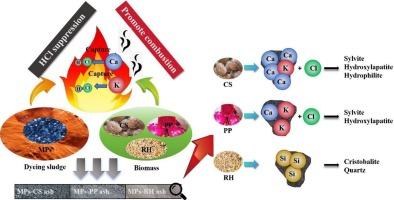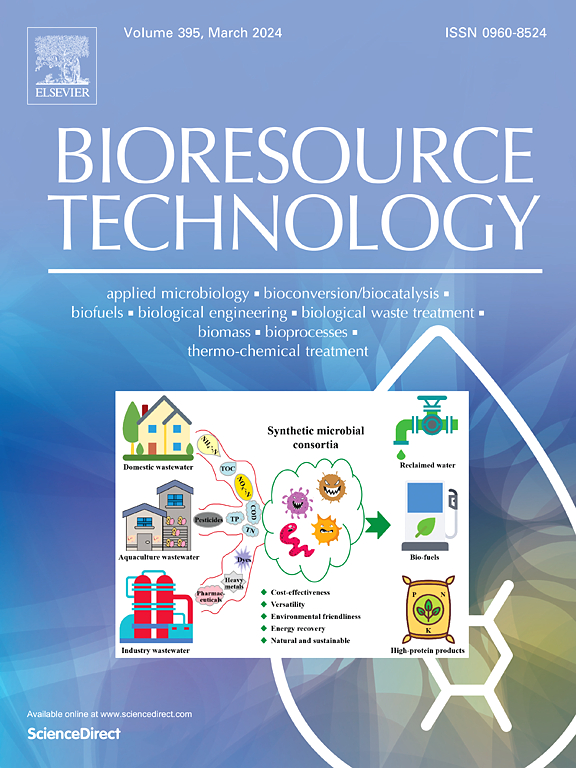When biomass meet microplastic during dyeing sludge incineration: The impacts on thermal characteristics, gas evolution, and chlorine cycle
IF 9
1区 环境科学与生态学
Q1 AGRICULTURAL ENGINEERING
引用次数: 0
Abstract
Co-combustion of dyeing sludge (DS) and biomass enables energy recovery and conventional pollutant passivation, yet biomass’s impact on microplastics (MPs) degradation remains uncharacterized. This study investigates three representative biomass fuels—crab shell (CS; Ca-rich), pitaya peel (PP; K-rich), and rice husk (RH; Si-rich)—on polyvinyl chloride (PVC) MPs combustion via integrated analysis of combustion characteristics, gas evolution, kinetics, and residue chemistry / mineral analysis. Biomass additives shifted PVC mass loss to lower temperatures and reduced ignition (Ti) and burnout (Tf) temperatures, indicating catalytic degradation by inorganic constituents from biomass. Contrary to expectations, co-combustion of PVC with biomass reduced CO2, H2O, and HCl yields. CS achieved 95.70 % HCl suppression (0.35PVC/CS) versus pure PVC. PVC-CS interactions accelerated ignition while suppressing gas emissions, particularly HCl. Co-combustion kinetics remained PVC-dominated, with biomass increasing activation energy (E) for PVC dehydrochlorination (inhibiting HCl release) while decreasing E for devolatilization / char combustion (catalyzing degradation). Among biomass additives, CS demonstrated superior chlorine fixation capacity (443.44 mg/g) through formation of chlorine-bearing minerals (hydroxylapatite, hydrophilite, sylvite) via Ca/K-HCl reactions, with calcium providing the predominant contribution. Collectively, co-combustion of DS with calcium-rich biomass represents a promising waste management strategy for simultaneous MPs degradation and chlorine emission mitigation.

印染污泥焚烧过程中生物质与微塑料相遇:对热特性、气体演化和氯循环的影响
染色污泥(DS)和生物质的共燃烧可以实现能量回收和常规污染物钝化,但生物质对微塑料(MPs)降解的影响仍未表征。本研究通过综合分析燃烧特性、气体演化、动力学和残留化学/矿物分析,研究了三种具有代表性的生物质燃料——蟹壳(CS; Ca-rich)、火龙果皮(PP; K-rich)和稻壳(RH; Si-rich)在聚氯乙烯MPs上的燃烧。生物质添加剂将PVC的质量损失转移到较低的温度,降低了着火(Ti)和燃尽(Tf)温度,表明生物质中的无机成分具有催化降解作用。与预期相反,PVC与生物质共燃烧降低了CO2, H2O和HCl的产量。与纯PVC相比,CS对HCl的抑制率达到95.70% (0.35PVC/CS)。PVC-CS相互作用加速点火,同时抑制气体排放,特别是HCl。共燃烧动力学仍然以PVC为主,生物质增加了PVC脱氢氯化(抑制HCl释放)的活化能(E),而降低了脱挥发/炭燃烧(催化降解)的活化能(E)。在生物质添加剂中,CS通过Ca/K-HCl反应生成含氯矿物(羟基磷灰石、亲水石、钾盐),以钙为主,表现出较强的氯固定能力(443.44 mg/g)。总的来说,DS与富含钙的生物质共燃烧代表了一种有前途的废物管理策略,可以同时降解MPs和减少氯的排放。
本文章由计算机程序翻译,如有差异,请以英文原文为准。
求助全文
约1分钟内获得全文
求助全文
来源期刊

Bioresource Technology
工程技术-能源与燃料
CiteScore
20.80
自引率
19.30%
发文量
2013
审稿时长
12 days
期刊介绍:
Bioresource Technology publishes original articles, review articles, case studies, and short communications covering the fundamentals, applications, and management of bioresource technology. The journal seeks to advance and disseminate knowledge across various areas related to biomass, biological waste treatment, bioenergy, biotransformations, bioresource systems analysis, and associated conversion or production technologies.
Topics include:
• Biofuels: liquid and gaseous biofuels production, modeling and economics
• Bioprocesses and bioproducts: biocatalysis and fermentations
• Biomass and feedstocks utilization: bioconversion of agro-industrial residues
• Environmental protection: biological waste treatment
• Thermochemical conversion of biomass: combustion, pyrolysis, gasification, catalysis.
 求助内容:
求助内容: 应助结果提醒方式:
应助结果提醒方式:


